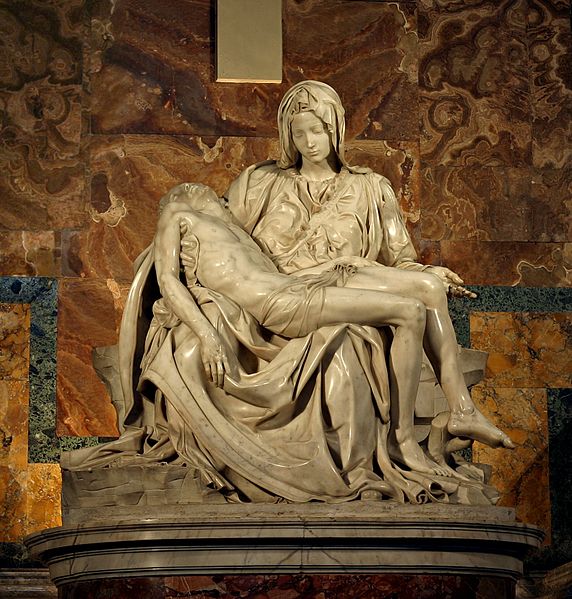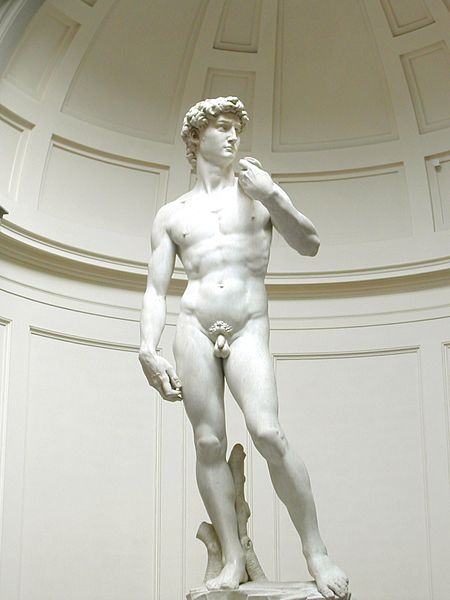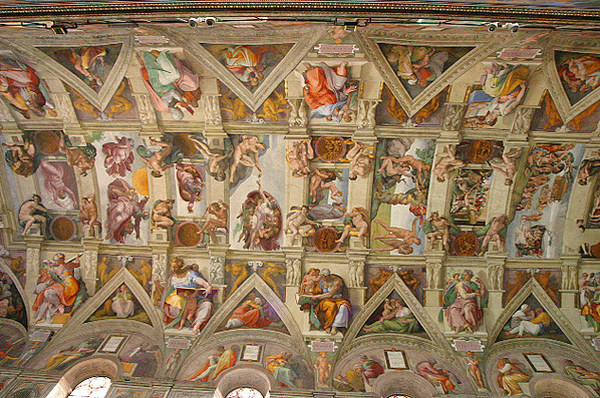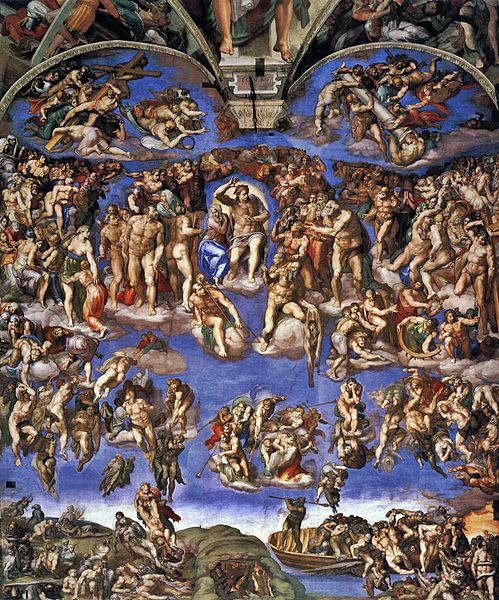Michel Angelo
Michel Angelo was not only one of the greatest painters the world has ever known, but he was also "The greatest of all sculptors." He was born in Caprese, Italy in 1745.
His family occupied a position of importance in the mercantile life of his native town, and his father was keenly disappointed, when at an early age, Michel Angelo showed a natural love and talent for art. For some years the father tried to discourage his young son, but his efforts in that direction proved futile, he finally apprenticed him to an artist named Ghirlandajo for practice and instruction. But Michel Angelo's apprenticeship was of brief duration and this is how it came about.
Lorenzo do Medici, a patron of the arts, desiring to secure for his school only the most promising pupils in the art world of Florence, sent messengers to all the leading studios asking the artists to bring their best students to the art center.
Michel Angelo was among the number, and was one of the lucky aspirants. He was accepted as a pupil in the Academy. This was a fortunate change for the young artist.
Lorenzo took a personal interest in the progress shown by each of the young men whose talents were being developed in the Academy under his patronage. He soon recognized Michel Angelo's ability and was so impressed by his remarkable talent that he decided to take him into his own home as one of the family.
With this idea in mind, he sent for the boy's father and finding him agreeable to the plan, immediately made arrangements for Michel Angelo to live with him and enjoy all the privileges and opportunities in a position of importance similar to his own sons in the mercantile life of his native town.
The death of his patron, Lorenzo di Medici, who was known as "The Magnificent" helped to make Michel Angelo more unhappy. Lorenzo was succeeded by his son, Piero, a selfish and incompetent young man. He lacked the ability, ambition, and community interest that had characterized the work of his father, and after a short time, the citizens rebelled, and together with other members of his family, he was forced to flee from the city.
A spirit of unrest had been felt throughout Florence for weeks before the final outburst, and prior to that date several students from the Medici Art Center had fled from the city, Michel Angelo among them.
He was without funds, and upon arriving in Bologna where he sought refuge, he secured work with a sculptor. He remained in the service of this man until the troublous times in Florence were over. Then he returned to the field of his studies and early labors. It was about that time that the attention of the entire art world centered on Michel Angelo and this is how it came about.
The young artist loved to work with his chisel, and his happiest hours were spent converting a block of stone or marble into a thing of beauty. For some time he had been working on a statue of Cupid, and when it was completed his friends were amazed at its beauty and perfection. This work was produced by Michel Angelo at a time when art lovers were searching everywhere for art treasures. In fact, the quest for beauty had inspired them to dig beneath the surface of the earth in their efforts to bring to the light of day, sculptured works of the Ancient Greeks. Many of the searchers had been richly rewarded by unearthing several pieces of statuary of great value. This had spurred the workers on to greater efforts. With this knowledge in mind one of Michel Angelo's friends suggested that the artist bury his statue in a place where it would be unearthed by the men digging for the Greek art treasures.
The proposition was apparently pleasing to the young artist for a short time later, the statue was dug up and accepted by the Art World as an antique. It was purchased for a large sum of money by a Roman Cardinal, but the artist, unwilling to profit by the deception, went to the purchaser and returned the money.
The Cardinal was so impressed by Michel Angelo's ability and honesty that he invited him to visit Rome. The artist promptly accepted the invitation and it was int "Eternal City" that his greatest work was done.
His first commission was "The Pieta" executed in marble in St. Peter's, the most beautiful of all statues of the Madonna, and one which knows no peer in the world of art. This statue represents the Mother of God holding in her arms the lifeless body of her Divine Son. Her expression in her grief is full of sheetness and sorrow as she humbly bows her head in submission to the will of God. In fact, her whole attitude is one of sorrowful resignation. Writers tell us that this statue of the Blessed Virgin and her Divine Son have remained unequaled in the field of art, for even Michel Angelo, the "Prince of Sculptors" never carved anything to equal this, his first great work, and its completion and unveiling placed him on the pedestal he has since that day occupied all by himself.

The Pieta, 1499
St. Peter's Basilica in the Vatican
Michelangelo (1475-1564)
When "The Pieta" was unveiled, the people flocked from far and near to view it, princess and peasants, art lovers, and alymen alike. Many did not even know the name of the sculptor who had carved this beautiful statue so full of pathos and dutiful resignation. And this almost life like statue of the Mother of God holding the lifeless body of her Divine Son is distinguished from all Michel Angelo's works. It is the only work of his hands inscribed by him with his name.
There is an interesting story in connection with this. We are told that unrecognized, the artist mingled with the crowds who came daily to view the statue. On one occasion he overheard the discussion of the members of a party who could not agree on the name of the sculptor who had conceived and carved "The Pieta." Determined that never again would there be any doubt about the name of the creator of the statue, Michel Angelo awaited an opportunity, and when there was no one around, engraved his name on the girdle of the Blessed Mother, and there it remains today, a mute proof of his pride in this, the most perfect statue ever carved by human hands.
Michel Angelo returned to Florence in 1501, and this event brought joy and gladness to the hearts of his fellow citizens. Many years previous to that time the Florentines had conceived the idea of having a gigantic statue carved from an enormous block of marble. But the sculptor who had been entrusted with the commission found the task an impossible one for him, and for years the marble had lain untouched by the hands of an artist.
Michel Angelo accepted the commission, and undaunted by the colossal task that faced him, at once began the work of converting the marble into a statue worthy of a place of honor in his native city.
For almost three years he worked untiringly, and when the statue was completed and the citizens of Florence assembled for the unveiling of the results of the artist's labors, a "Masterpiece in Sculpture" met their eyes, the colossal statue of David, which for centuries has been the pride of the Florentines.

David, 1504
Michelangelo (1475-1564)
Up to this period in his life, Michel Angelo had devoted but little of his time to painting, but at the request of some of the officials of Florence, he began the unfinished fresco "Bathing Soldiers" on the wall of Palazzo Vecchio in competition with Leonardo da Vinci whose painting on the opposite wall was entitled "The Struggle for the Standard."
Neither fresco was ever completed, as Leonardo was disappointed with the development of his picture and abandoned it just about the time that his competitor was called to Rome by Pope Julius 11.
Upon arriving in that city, Michel Angelo was commissioned to carve a tomb for the Pope, but the enormous sepulchre conceived in the mind of Julius 11 never materialized, for after the artist had spent months in the quarries of Carara selecting marble to be used in the carving of the statues that were to adorn the tomb, the plan was abandoned by the Pope himself.
But Julius 11 was not through with Michel Angelo. He had another prodigious commission for him, the painting of the ceiling of the Sistine Chapel.
Michel Angelo was not at all pleased with this plan, as he insisted that he was a sculptor and not a painter, but the Pope would not take no for an answer and was so persistent that Michel Angelo finally accepted the commission, and in May, 1508, he began the gigantic work.
The Sistine Chapel is a room 50 by 150 feet and the task of drawing up designs to fill the ceiling space was enough to discourage even the most able painter of the day. But the mighty Michel Angelo did not hesitate. He immediately set to work laying out his plan and at the same time superintended the erection of a scaffold on which to stand while he worked on the ceiling.
He also busied himself hunting up the best fresco artist of the day to fill in the color that would serve as a background for his designs, but their work did not satisfy him and discharged all of them. Then locking himself in the chapel, he began the execution of the stupendous undertaking all by himself. First, he wiped out the work of his assistants and filled in a background of heavenly blue. Then he began to fill in the figures and scenes that would tell the story of the Book of Genesis, the first book of the Bible. This colossal work is made up of nine scenes, five representing the story of the Creation. They are:
- "The Separation of Light and Darkness"
- "The Creation of the Sun and Moon"
- "The Creation of Trees and Plants"
- "The Creation of Adam"
- "The Creation of Eve"
The remaining four scenes continue the story of the Book of Genesis as interpreted by Michel Angelo. They cover:
- "The Fall of Adam and Eve and their Expulsion from Paradise"
- "The Deluge"
- "The Sacrifice of Noah"
- "The Intoxication of Noah"

The Sistine Chapel Ceiling, 1508-1512
Michelangelo (1475-1564)
The Fall of Adam and Eve and Their
Expulsion From Paradise
When God had created Adam and Eve, He placed them in a garden in which all kinds of trees and precious fruits were growing. This was the garden of Paradise. Now in the center of this garden God placed two trees; one the tree of life, the other the tree of knowledge of good and evil.
God then told Adam that he might eat of the fruit of every tree in the garden except that of the tree of knowledge of good and evil; for on the day he would eat of fruit of that tree he would surely die.
Adam and Eve were very happy in their home, but the devil, who had been cast out of heaven, was jealous of their innocence and happiness, and resolved to destroy them.
To accomplish this design he took the form of a serpent, and approaching Eve, who was alone at the time, he asked her why she did not eat of the fruit of the tree of knowledge. Eve told the serpent that God had forbidden them to eat of it under pain of death. But the serpent cunningly assured Eve that they would not die, but their eyes would be opened and they would be as gods. Finally Eve was convinced, and she ate of the forbidden fruit and gave some to Adam who also ate. Their eyes were opened, but not in the way Satan had promised them. They saw only the good they had lost and the unhappiness into which their disobedience had plunged them.
Filled with shame, they made garments out of fig leaves, tremblingly hid among the trees.
In the evening God came into the garden and called the guilty pair before Him. Adam acknowledged he had eaten the forbidden fruit, but blamed Eve who had given it to him. Eve in turn blamed the serpent.
Then God cursed the serpent, and after making garments out of skins, clothed Adam and Eve in them, and drove them out of the gardens of Paradise. At the entrance He placed an angel with a flaming sword to prevent their return.
The Deluge
Adam had three sons, Cain, Abel and Seth. Cain slew Abel, and became a fugitive upon the earth. He was a very wicked man, and his descendants followed in his footsteps. They were called the "children of men" while the children of Seth were called the "children of God."
The descendants of Seth remained faithful to God for a long time, but finally intermarried with the posterity of Cain. Their children were very wicked and all mankind became corrupt. This corruption was so universal that only one man remained faithful and true to God. That man was Noah.
God now decided to destroy the inhabitants of the earth with the exception of Noah and his family, and so He commanded him to build an ark three hundred cubits long, fifty cubits wide and thirty cubits high.
Noah worked for one hundred years building the ark, and during all that time he preached penance to the people and warned them of the disaster that was to come, but they did not pay any attention to him.
When the ark was completed, God commanded Noah to enter it and take his wife and his three sons and their wives with him; also of every animal two of a kind, and sufficient food for all.
Then for forty days and forty nights God caused a rain to fall upon the earth until the waters were fifteen cubits higher than the highest mountains, and every living thing upon the earth at that time was destroyed, the only survivors being the occupants of the ark.
The Sacrifice of Noah
For one hundred fifty days the ark was tossed about by the waters; then God sent a warm wind and by degrees the flood was abated. In a short time the tops of the mountains came into view, and the ark finally came to rest on Mount Ararat in Armenia.
Seven days later Noah sent forth a dove so that he might learn if the waters had subsided. In the evening the dove returned.
The Intoxication of Noah
Michel Angelo spent four years in the completion of this great work, and when the scaffolding was removed in 1512, the whole world marveled at the magnitude of its conception and execution.
But the artist's work was not finished in the Sistine Chapel, for twenty years later, he began the painting of his other great picture, "The Last Judgement" on the wall at the end of the Chapel. In this painting we see pictured the artist's conception of the power and majesty of God, Who sits in judgement, while varying expressions of hope and despair are depicted on the countenances of the condemned.

The Last Judgement, 1536-1540
Sistine Chapel in Vatican City
Michelangelo (1475-1564)
In 1547 when Michel Angelo was seventy-two years old, he was appointed architect of St. Peter's, Rome. In this position, he labored until the end came in 1564, daily enriching the world by the products of his remarkable genius.
And now, children, we will take up the work of Raphael, the most beloved of the artists of the "Golden Age".
| Page 13 | Beginning of Book | Page 15 |